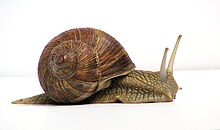User:Hereandnow101/sandbox
This article needs additional citations for verification. (March 2010) |


Snail is a common name which is applied most often to land snails, terrestrial pulmonate gastropod mollusks. The name is however also applied to most members of the molluscan class Gastropoda that have coiled shells large enough to retract into. When the word "snail" is used in its most general sense, it also includes sea snails and freshwater snails. Some other mollusks that are not even gastropods, such as the monoplacophora, may also informally be referred to as "snails".
Snail-like animals that naturally lack a shell, or have only an internal shell, are often called slugs, and land species that have only a very small shell (that they cannot retract into) are called semislugs.
Overview[edit]
Snails that respire using a lung belong to the group Pulmonata, while those with gills form a polyphyletic group; in other words, snails with gills form a number of taxonomic groups. These groups are not really more closely related to each other than they may be to other species. Snails with lungs and with gills have diversified so widely over geological time that a few species with gills can be found on land, numerous species with a lung can be found in freshwater, and a few marine species have lungs.
Snails can be found in a very wide range of environments including ditches, deserts, and the abyssal depths of the sea. Although many people are familiar with terrestrial snails, land snails are in the minority. Marine snails constitute the majority of snail species, and have much greater diversity and a greater biomass. Numerous kinds of snail can also be found in freshwater. Most snails have thousands of microscopic tooth-like structures located on a ribbon-like tongue called a radula. The radula works like a file, ripping food into small pieces. Many snails are herbivorous, eating plants or rasping algae from surfaces with the radula, though a few land species and many marine species are omnivores or predatory carnivores.

